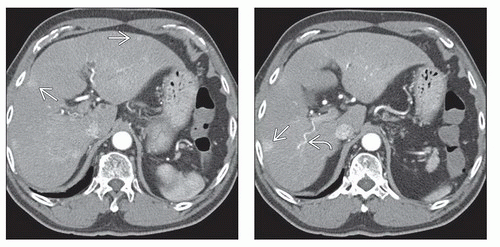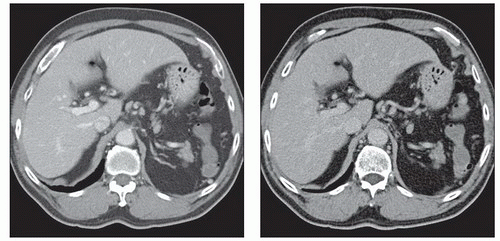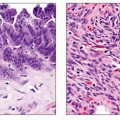Arterioportal Shunt
Michael P. Federle, MD, FACR
Brooke R. Jeffrey, MD
Key Facts
Terminology
Communication between branch of hepatic artery and portal venous system
Imaging
Best diagnostic clue
Wedge-shaped area of hyperattenuation with straight margins seen during arterial phase of CECT or MR
Becomes isodense to hepatic parenchyma during portal venous phase of CECT or gadolinium-enhanced MR
Peripherally within hepatic segment or lobe
Usually ≤1.5 cm (e.g., cirrhotic AP shunts)
Larger in some cases of post-biopsy AP shunts
Early enhancement of peripheral portal vein (PV) branches prior to visualization of main PV
Top Differential Diagnoses
Hypervascular liver mass (e.g., HCC)
Usually round or oval, not wedge-shaped
Usually shows washout on venous phase
Hemangioma
Attenuation tracks blood pool on all phases
Pathology
Small AP shunts are not amenable to biopsy
Too small; invisible on NECT & US
Diagnostic Checklist
Small (< 1.5 cm) AP shunts are common in cirrhosis
If unassociated with focal lesion on MR, it is probably insignificant
Follow-up in ˜ 6 months is indicated & adequate
TERMINOLOGY
Abbreviations
Arterioportal (AP) shunt
Definitions
Communication between branch of hepatic artery and portal venous system
IMAGING
General Features
Best diagnostic clue
Nodular or wedge-shaped area of hyperattenuation with straight margins seen during arterial phase of CECT or gadolinium-enhanced MR
Becomes isodense to hepatic parenchyma during portal venous phase of CECT or gadolinium-enhanced MR
Location
Peripherally within hepatic segment or lobe
Size
Usually ≤ 1.5 cm (e.g., cirrhotic AP shunts)
Larger in some cases of post-biopsy AP shunts
Transient hepatic attenuation difference (THAD) & transient hepatic intensity difference (THID) can be much larger
Can involve entire hepatic segment or lobe
Morphology
Wedge-shaped with straight margins
Imaging Recommendations
Best imaging tool
Multiphasic CECT or gadolinium-enhanced MR
Protocol advice
Arterial phase acquisition of CECT or MR at 25-35 seconds after injection
Followed by venous phase (60-70 seconds) and delayed phase (˜ 120 seconds)
CT Findings
Arterial phase imaging
Early enhancement of peripheral portal vein (PV) branches prior to visualization of main PV
Peripheral wedge-shaped area of increased attenuation with straight edges within affected segment or lobe
Aberrant blood supply (capsular veins, accessory cystic veins, aberrant right gastric vein) causes systemic venous blood to drain into sinusoids
Hyperdense areas on arterial phase imaging
Portal venous & delayed phase imaging
Area of previously increased attenuation equilibrates, nearly isodense with rest of liver
Cause of larger AP shunt (e.g., PV thrombosis, hepatic mass) may be more visible during portal venous phase
Stay updated, free articles. Join our Telegram channel

Full access? Get Clinical Tree








